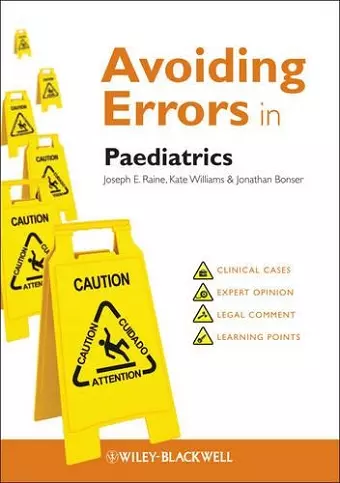Avoiding Errors in Paediatrics
Kate Williams author Joseph E Raine author Jonathan Bonser author
Format:Paperback
Publisher:John Wiley and Sons Ltd
Published:25th Jan '13
Currently unavailable, and unfortunately no date known when it will be back

Some of the most important and best lessons in a doctor’s career are learnt from mistakes. However, an awareness of the common causes of medical errors and developing positive behaviours can reduce the risk of mistakes and litigation.
Written for junior paediatric staff and consultants, and unlike any other paediatric clinical management title available, Avoiding Errors in Paediatrics identifies and explains the most common errors likely to occur in a paediatric setting - so that you won’t make them.
The first section in this brand new guide discusses the causes of errors in paediatrics. The second and largest section consists of case scenarios and includes expert and legal comment as well as clinical teaching points and strategies to help you engage in safer practice throughout your career. The final section discusses how to deal with complaints and the subsequent potential medico-legal consequences, helping to reduce your anxiety when dealing with the consequences of an error.
Invaluable during the Foundation Years, Specialty Training and for Consultants, Avoiding Errors in Paediatrics is the perfect guide to help tackle the professional and emotional challenges of life as a paediatrician.
“My experience as an expert witness in clinical negligence cases, MPTS Panel chairman, medical adviser to a Public Inquiry and as a sometimes commissioned independent reporter on adverse incidents tells me that these are excellent books, valuable for all clinicians, not just those in high-risk specialties; and all NHS managers involved in maintaining or improving the quality of care. The case vignettes, alone, are useful source material for teaching medical trainees on what can go wrong and how to deal with it when it does.” (Harvey Marcovitch, Clinical Risk journal)
"This book is well written and easily read. It is divided into three main parts. The first part deals in general terms with the areas in which errors tend to occur. The importance of good communication, both written and oral, is repeatedly stressed. The contribution of poor management and of system errors in the creation of problems is not overlooked. The section on legal aspects of errors, including discussion of negligence, consent and confidentiality is concise and clear.
The second part consists of thirty-six case studies. These are interesting and thought provoking, with questions for the reader at significant points in the progress of each case. An expert opinion, legal comment and key learning points are given at the conclusion of each case.
Part 3 gives information and advice on responding to complaints, managing mishaps and navigating the hazards of police, court and GMC involvement. Again it is concise and helpful.
After sections 1 and 3, and after every case study in section 2, references and suggestions for further reading are given.
I would strongly recommend this book to all paediatricians, at all levels. It is well structured, easy to read and informative. I would also like to see medical and non-medical managers reading it, as it puts into perspective the role of system failures that so often contribute significantly to clinical errors. I think that general practitioners would also find it well worth reading." (Hilary Haines, F.R.C.P.C.H., F.F.P.H.)
Pre-publication reviews:
“I think in Medicine it is always best to learn from others’ mistakes rather than waiting until you make your own. In addition, knowing what you can expect if a complaint is made goes some way to emphasising the importance of avoiding errors in the first place. Should a complaint be made, forewarned is forearmed.” (ST1 in Paediatrics)
“The format of presenting “real life” cases with expert clinical and legal commentary is both entertaining and highly informative.” (Consultant Paediatrician)
ISBN: 9780470658680
Dimensions: 244mm x 172mm x 8mm
Weight: 1361g
192 pages